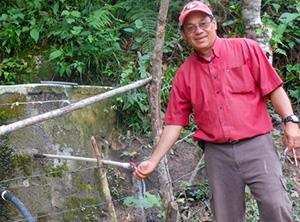 The water system installed in each village is designed by Honduran engineer Arnoldo Alvarez and his team to be low-maintenance and efficient, powered entirely by gravity and constructed of bricks, cement, and PVC pipes.
The water system installed in each village is designed by Honduran engineer Arnoldo Alvarez and his team to be low-maintenance and efficient, powered entirely by gravity and constructed of bricks, cement, and PVC pipes.
Arnoldo's systems have been used extensively in Honduras and most are still in operation after decades of use. We appreciate this key player in the work of the Wheaton Honduras Project.
Where does the water come from?
For each year's project a clean mountain spring is located at an elevation above the highest house in the village. The village purchases the land around the source to ensure that it is not polluted by future development. Water from the spring is funneled into a cement box with two outputs on the downhill side. The top output sends water via PVC pipes down to the village, while the lower output drains sediment from the box.
How does it get to a village?
The water is transported through 3.5 inch PVC pipes on its way to the village. The pipes are buried approximately 50 cm deep to avoid being punctured by future road development, plows, etc. Throughout the system, the hydraulic head is carefully calculated to avoid bursting the pipes. Where necessary, concrete pressure boxes are constructed to regulate water pressure. As pipelines diverge to disperse water to different parts of the community, pipe diameter decreases to 2 inch, 1 inch, and 3/4 inch PVC. A faucet is installed in each household that participates in the project, providing instant access to clean, flowing water.
Storage Tanks
At least one large tank is constructed as part of the system to store water as well as to regulate pressure. The tank must be at a higher elevation than the highest house in the village and must be large enough to hold a one-day supply of water for the entire community. The tank is round, built above a bed of rocks. It is constructed of bricks and mortar and sealed with cement, with a cover to prevent matter from falling in and contaminating the water. The tank is designed so that, if contamination does occur, a chlorine drip purification system can be easily installed.
What happens when the team leaves?
About ten men in the village are taught everything about the system to assist in construction and in the event of needed maintenance. One man is paid a small sum annually by each family receiving water to maintain and clean the system. Part of the cost of the project goes towards purchasing additional supplies to be stored for future repairs or maintenance. The Honduran government gives the water systems a 20 year life expectancy, but Arnoldo's first system, installed over 20 years ago, is still functioning perfectly.